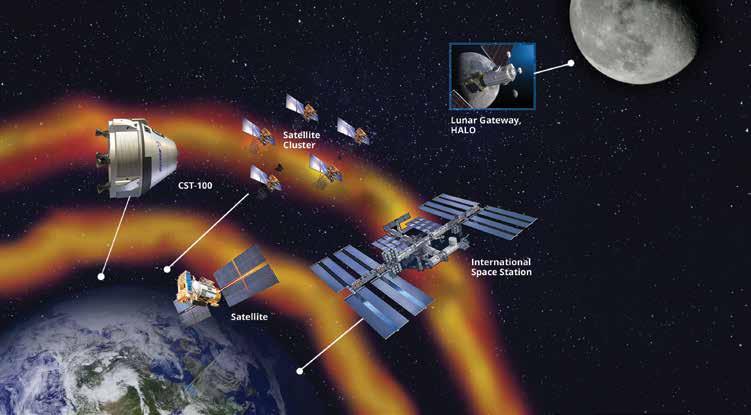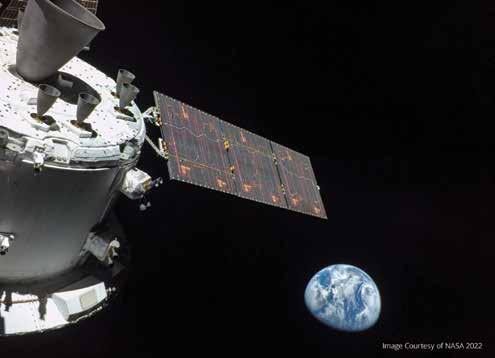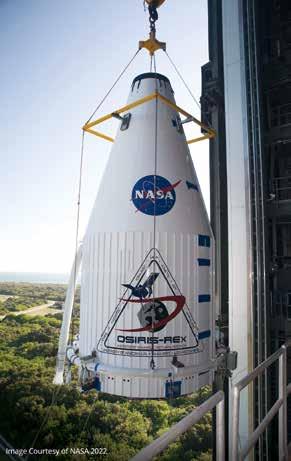
6 minute read
Modern Space Innovations Open New Realms of Communication and Connectivity Across All Orbits
by RTC Media
By Ralph Grundler, Director of Space
Business Development, Aitech
Space is no longer the sole domain of government agencies and aerospace & defense companies. With new players and technological goals entering the space sector, the capabilities of new space electronics are encouraging the deconstruction of past methods and pushing for a new and improved world order of space technologies.
With this growing renewal of interest to explore space, from expanding low earth orbit (LEO) and near earth orbit (NEO) applications to innovating technologies for the potential of GEO and lunar missions as well as long-term habitation in space, comes a hotbed for new applications. (Figure 1)
What Today’s Space Innovations Look Like
Space exploration drives a continuous effort to design capable, reliable, and efficient systems. The idea that space electronics should be one large, all-or-nothing, expensive system is becoming a concept of the past. The space industry is constantly pushing for designs with tighter system integration and increased computing performance; meaning engineers are then asked to fit these goals within the particularly small size, weight, and power (SWaP) profiles.
Growing sectors in space technologies have led to the expansion of what is possible in space. Optimized payload and launch technologies are as critical to today’s space exploration as satellites, spacecraft, and stations being put into orbit. New innovations are constantly being woven into space electronics to ensure system survival through the severe shocks, temperature, EMI, and radiation of the space environment.
Levels of radiation in space can cause various problems for electronic components. While there are rad-hard electronic parts that resist the effects of radiation, these can become very expensive, and not all space missions require this as intense radiation resistance. Rad-hard boards and systems certainly have a home in space electronics but are best suited for specific application environments. And in comparison to applications requiring less radiation tolerance, overall demand for rad-hard electronic parts is relatively low, which can drive up their costs even more.
Traditional space suppliers needed space-graded electronics that meet cost restraints while maintaining the necessary radiation resistance. With commercial off-the-shelf (COTS) components, these abilities can be met.

COTS is a concept that has been introduced previously; its popularity has increased due to the commercial market expansion. COTS systems can capitalize on proven computing technologies in highly rugged space environments, creating a cost-effective method to rapidly conceptualize innovations in areas such as launch vehicles, payloads, satellites, and future habitats.
Four Growing Space Pillars
While there are several instances where space electronics are fueling innovations, here we look at four distinct areas that provide a deeper look into market shifts to come.

Habitat: As space exploration expands, the concept of habitats to safely host humans in harsh space conditions is becoming more relevant. As seen with the Lockheed Martin-built Orion spacecraft flown during the recent Artemis, I mission to the Moon and back, mankind’s progress towards inhabiting space is in the sites of space program developers. The ultimate goal of habitat development in space is to provide long-term, sustainable living spaces for humans.
Artificial Intelligence (AI) has been tasked with ensuring that space habitats are viable by analyzing equipment data and enabling situational awareness to provide data and recommended decisions to occupants. The growing number of compute-intensive mission-critical applications pushing the envelope of data processing at the edge of space need reliable, radiation-tolerant, and proven technologies.
In addition to a media converter that provided information connectivity as the main conduit data interface between Orion and the Electrical Ground Service Equipment (EGSE), Aitech’s C878 3U VPX Intel Xeon D-based SBC provided the computational core of Callisto (including Amazon’s Alexa voice-activated virtual assistant and Cisco’s WebEx) and intercom capabilities. Onboard Orion, Callisto was a payload to test and demonstrate how commercial technology could support future crewed missions in space. (Figure 2)
Satellite: A new wave of satellite technology innovation has emerged in recent years. Low-cost space access and the smaller size and weight of satellites have revolutionized the space industry and space exploration for all players. By reducing satellite costs, there are many new opportunities for exploration and research. With COTS, small satellites (smallsats) rapidly replace their larger and more costly predecessors. This allows agencies to send hundreds of networked smallsats into low-earth orbit, creating unified con- stellations to provide global coverage.
Smallsats are creating new opportunities in communication, navigation, earth observation (EO), and research and development for the space industry. LizzieSat, the flagship multi-mission microsatellite from Sidus Space, a leading Space-as-a-Service satellite company, seamlessly links with the Sidus constellation to leverage the complete in-space services of the Sidus fleet. Aitech has provided custom Command and Data Handling (C&DH) flight computers and peripherals for this program.
Payloads: Constantly growing more sophisticated, payload systems have enabled the testing of new technologies in space by contributing to the understanding of and response to the increase in available data. The variety of payload types has increased, encompassing communication, navigation, observation, scientific, human support, cargo, etc., all of which help determine the capabilities and limitations of developmental space technologies. To survive severe shocks, vibration, temperature, EMI, pressure, and radiation, payloads require ruggedization yet must still be lightweight and as compact as possible to reduce launch costs and maximize the space on the spacecraft or rocket.
Payloads are the part of a spacecraft or rocket tasked with achieving a mission’s objectives. Scientific payload systems, for example, are used to study various aspects of space and the impacts that may affect people on Earth. Particularly, OSIRIS-Rex provides NASA with insight into the Bennu asteroid by collecting samples. Bennu’s close orbit can be potentially hazardous to Earth, but with the advanced technology this payload systems provide, scientists can take preventive measures long before impact. In addition, this spacecraft includes a suite of scientific instruments to study Bennu’s geology, mineralogy, and composition, as well as its orbit and rotation. (Figure 3)

Launchers: For payloads, satellites, or any spacecraft to be released into space, launchers must generate massive amounts of momentum to overcome Earth’s gravity and successfully put space systems into orbit. High costs have been a bottleneck since previous launch technologies had a one-and-done lifespan.
With recent developments and multiple launch techniques in evaluation, reusable launchers are encouraging more innovative, cost-effective solutions for the future of space. For example, Aitech’s NVIDIA-based, space-characterized S-A1760 Venus AI supercomputer became the first use of GPGPU technology in space during the successful launch and re-entry of NASA’s Low-Earth Orbit Flight Test of an Inflatable Decelerator (LOFTID) in November 2022.
Defining the Space Digital Backbone
The common thread of today’s space exploration is the digitalization of electronics using COTS systems that rely on open standards and highly adaptive scalability. COTS systems are heavily applied to the Space Digital Backbone (DBB). This “information highway” approach provides a unified, flexible, and scalable communication infrastructure for the increasing number of IoT technologies implemented into space technologies. (Figure 4)
The Space DBB enhances space electronics across all orbits by removing connectivity and computing limitations and the associated performance bottlenecks that have forced spacegrade, radiation-tolerant electronics to lag generations behind Earth-bound technologies.

The Space DBB architecture includes four main elements:
• Open Standard Networking
• Edge Computing with AI/ML
• Network Attach Storage (NAS)
• Cybersecurity
This concept has paved the way for unprecedented space innovations, including the launch of the commercial space market, such as Virgin Galactic’s successful 90-minute suborbital flight of the Unity V22 that utilized a rocket motor controller from Aitech as well as the development of the NASA HALO lunar gateway for longterm deep space exploration and redundant smallsat constellation networks, like LizzieSat from Sidus Space. The Space DBB streamlines high-performance onboard computing and expedites valuable data assets for transmissions, eliminating significant technical challenges, like extremely slow communications.
The Future of Space
The opportunities can be endless by implement- ing the Space DBB techniques into the current space industry focus. COTS hardware in a Digital Backbone architecture enables space solutions providers to meet aggressive schedules using proven, reliable embedded designs to mitigate program and mission risks throughout the lifecycle of a space program. With AI and edge computing, space applications can take gathered data and efficiently discover patterns and anomalies to ensure successful innovations for the future.
There is a growing need for reliable, space-rated systems that meet the ever-evolving technology requirements around communication, imaging, and processing capabilities. Proven and reliable COTS electronics enable aggressive development-to-deployment schedules and provide embedded designs with enhanced capabilities and performance.
The space industry and the opportunities it presents will only continue to grow. A paradigm shift in the approach to building space electronics has paved the way for a whole new economy of commercial spaceflight and the development of future versatile space missions. Using cost-effective COTS-based electronics across the Space DBB infrastructure reduces latency risk and cost while increasing connectivity throughout LEO to the deepest space missions, ultimately helping to build a far more efficient and intelligent space industry.









